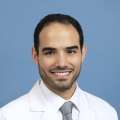Nearly 16 million Americans are diagnosed with COPD (chronic obstructive pulmonary disease), a group of lung diseases that make it hard to breathe and get worse over time. But according to the Centers for Disease Control and Prevention (CDC), millions more live with COPD but are not diagnosed and therefore not receiving treatment.
Reza Ronaghi, MD, a UCLA Health specialist in pulmonology and interventional pulmonology, points to two main reasons that COPD is underdiagnosed:
- People don’t recognize the symptoms, so they don’t seek care in a timely manner.
- People with symptoms don’t always seek care from the appropriate physician in the appropriate setting.
“Caught early, COPD is something we can fix or prevent from getting worse,” Dr. Ronaghi says. “But you need to recognize the signs and see a medical professional who can definitively diagnose COPD.”
To help you get the care you need when you need it, Dr. Ronaghi answers the “who, what, where, when, why and how” associated with COPD:
Who is at increased risk of COPD?
COPD can develop after long-term exposure to irritants that damage your lungs and airways. Everyone is at risk for developing COPD if they are exposed to the right amount of particles or pollutants, which include secondhand smoke, wildfire smoke , air pollution and chemical fumes.
But according to Dr. Ronaghi, there are two factors that immediately increase the risk for COPD:
- Family history of COPD: Your risk increases if your family members tend to develop COPD at a younger age or have alpha-1 antitrypsin deficiency, a genetic disorder.
- Smoking: Up to 75% of people with COPD smoke or were smokers.
What are the symptoms of COPD?
COPD symptoms often begin as mild, and include:
- Persistent cough, either dry or with mucus
- Shortness of breath, so that you can’t perform usual activities without stopping to catch your breath or gasp for air
COPD can progress for years unnoticed. That’s why it’s important to seek medical care when you first notice the symptoms. “Even though your symptoms may be mild at the time, they will continue to get worse,” Dr. Ronaghi says. “Once COPD progresses, no matter how hard you try to alleviate the symptoms, it may not be enough.”
Learn more about how COPD affects your lungs.
When should you see your doctor about COPD symptoms?
Coughing and shortness of breath may be symptomatic of several conditions including:
- Asthma, although onset is typically younger than 20 and symptoms vary over time and are not persistent
- Common cold, though symptoms should only last about 7 to 10 days
- COVID-19, which often also includes symptoms such as a low-grade fever, new loss of smell or taste and body aches
Dr. Ronaghi suggests you ask yourself some important questions to determine whether your symptoms require a visit to your physician:
- Are you over the age of 50?
- Are your symptoms persistent or have come and gone for a couple of weeks?
- Do you have a family history of COPD?
- Do you have a history of tobacco use?
If you have symptoms of COPD and answer “yes” to any of the questions above, see your primary care physician or a pulmonologist who can conduct further testing.
Where should you go if you have breathing problems possibly associated with COPD?
When people notice a cough that won’t subside or shortness of breath, they often head to urgent care or the emergency department (ED) instead of their primary care provider (PCP). But those settings may not be the most appropriate setting for diagnosing COPD.
According to Dr. Ronaghi, while emergency or urgent care physicians will treat acute symptoms, they don’t typically have the capability to test for COPD or conduct regular follow-up. Without seeing you repeatedly or really knowing your health history, acute care physicians won’t see continuing signs of a larger lung condition.
If you do need to visit an acute setting for symptom relief, Dr. Ronaghi recommends also making a follow-up appointment with your primary care physician to determine the underlying cause of those symptoms. “Diagnosing COPD is not difficult, but it’s important to see the right physician in the right setting so they can use the proper imaging and breathing tests to diagnose your condition,” he says.
Why is it important to seek COPD treatment?
While the lung damage inflicted by COPD cannot be reversed, COPD treatment may protect the healthy portion of the lungs. “When we catch COPD early enough, the goal is to prevent the rest of the lung from getting worse,” Dr. Ronaghi says. “It also allows us to alleviate some of the symptoms so you can still live a normal, active life. Don’t ignore the signs of COPD. Even if you’re unsure, get checked out.”
When left untreated, people with COPD may eventually require oxygen and may face life-threatening symptoms. According to the American Academy of Family Physicians, COPD is the third leading cause of death in America. COPD also increases your risk of pneumonia and serious complications from COVID-19, so it’s even more important to be vaccinated for COVID if you have COPD.
If you have symptoms of COPD, speak to your primary care provider.




